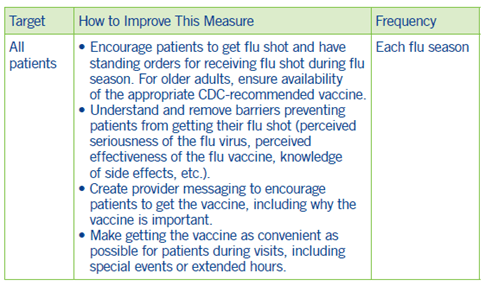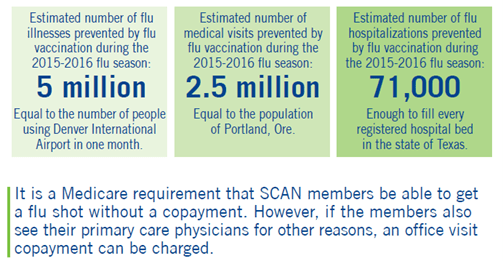Annual Flu Vaccine
Annual Flu Vaccine
The single best way to protect against influenza is to get the clinically appropriate vaccine at the beginning of each flu season. This is measured by CMS through the CAHPS by asking patients if they have had the most recent flu vaccine. Historically, Black and Spanish-speaking populations have lower vaccination rates than their white and Asian counterparts, so understanding barriers to these populations and addressing concerns and barriers will help make significant improvements.

Clinical Guidelines
- Encourage patients to come in early in the flu season for their shots.
- Have standing orders and a process to administer flu shots for walk-ins.
- Stock the vaccine so that you have it available to patients who need it.
- For SCAN members who have a hard time getting around and who have a transportation benefit, encourage them to use the free rides to take them to and from your office or their pharmacy to get their shots.
- Enlist the aid of caregivers to encourage your patients to get their flu shots.
- In addition to recommending the flu shot, advise your patients to observe the usual precautions during the flu season, such as avoiding crowded places, people who are ill and washing hands frequently.
- Set up auto-reminder calls to all your patients towards the start of the flu season.
- Consider offering flu shot clinics or even a FLU-FOBT.
- Provide take-home materials for patients’ records so that they remember receiving their flu shot.
- Medicare and most health plans, including SCAN, allow for vaccinations at contracted pharmacies. This is a convenient option for many patients.
Toolkits and Educational Tools
- The CDC provides a number of tools and materials to drive home the benefits of getting a flu shot. For example, the number of preventable flu illnesses, medical visits and hospitalizations are laid out in a table by the CDC.¹
- You can also get the state Flu Season Digital Media Toolkit from the CDC.²

Coding and Documentation Guidance
One set of procedure codes is used for the vaccines themselves, and one procedure code is used for the administration of the vaccine.³ Documentation should include the type of vaccine, route of administration, location of administration (for injections), batch number of the vaccine and date. There is a single code for administration of the vaccine, irrespective of route:

The administration code and one of the codes listed for annual flu vaccines in Appendix: Coding should be billed.4
¹ For more information, visit https://www.cdc.gov/flu/ and https://www.cdc.gov/flu/highrisk/65over.htm.
² For more information, visit https://www.cdc.gov/flu/resource-center
³ There is one diagnosis code: Z23 – encounter for immunization.
4 Only one code for the annual flu vaccine should be billed with the administration code.

